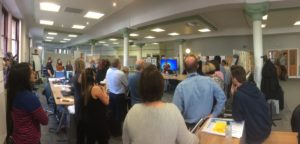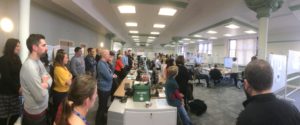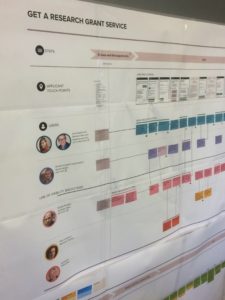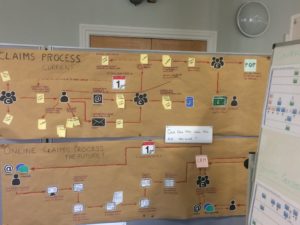Insight into Scottish Enterprise agile and UX processes
Last week I was invited to Scottish Enterprise to learn a bit about their agile development set up and how UX and service design are integrated into their practices.
I was invited over by David O’Brien who is a service designer there. We’ve known each other a long time and although we rarely meet (can’t remember the last time, in fact!), we have chats around interesting articles we post and updates on our professional activities through Linked In and Twitter. It was out of one of these that the invite came to see how three small teams are piloting more user-focused agile software enhancements.
David O’Brien’s Linkedin profile
David told me that the initiative had been a great success and they were now in the process of integrating these new approaches more closely into the business. While a big part of the Scottish Enterprise operation is based in Glasgow, this agile enclave was out in Paisley (about 10 minutes on the train out of the city).
The Scottish Enterprise Digital Team spend a lot of time sharing their work and their thoughts via a blog. I’ve spent a little time exploring and have a lot more reading to do. There are some great posts in there. I recommend it.
Scottish Enterprise Digital Team blog
Collaborative retrospective session
It was a lucky accident, but what had been intended to be a chat and a tour happened on a day when the three teams were running a retrospective of their work, with business stakeholders coming in to learn more too. So each team in turn had up to 30 minutes to speak informally about their recent work – the challenges, the insight, their achievements and upcoming plans.

Three development teams, plus stakeholders from across the business listen to a review of recent work.
Sounds like quite an undertaking, but the space in which they worked, and the way that they used wall space for their work-in-progress and planning, made this (at least it seemed to me) a very casual, yet well run, affair. Much like how agile development is intended to be, in fact.

The teams use whiteboards and display boards to break up a large room, and give them the allspice they need for collaboration and communication.
I came away with some great insight into how other public sector teams run their development, and ideas about how we might do things differently in the future.

Three development teams, plus stakeholders from across the business listen to a review of recent work.
Great space and processes
A few things that struck me about the Scottish Enterprise (I think it’s fair to say pilot?) set up:
The space in which they worked was fantastic. A long, open space with room for flexible collaboration and three cross functional development teams side-by-side. It wasn’t something that was covered on the day, but I imagine this is a great way to enable people of the same discipline working on different projects to support each other and share ideas.

Service design maps such as this externalise what the team believe they’re working towards, and serve as a focus for day-to-day meetings.
The walls were covered with their work. Where walls weren’t available, dividing boards had been put up. Their backlogs, Kanban boards, process maps, design concepts, usability testing results, ideas and questions were all there and evidently actively curated. These walls aren’t for decoration; they’re an active workspace around which meetings are held and collaboration and communication happen. As I mentioned above, it’s part of the reason that the retrospective seemed so casual as things on the walls were being referenced throughout.

The Scottish Enterprise teams are focussed on digital enhancement of services and processes, here comparing a now and potential future.
The focus on discovery and solving business problems came through very strongly in each team’s show-and-tell. There were lots of stories about identifying a business need and the (not always 100% successful) solutions they tried out. Knowing what success looks like from a business and a customer experience perspective was empowering them to innovate, and to know when to say “that’s enough for now” and move on to another problem they’d identified.

I love “Proceed until apprehended” which I interpreted as a variation on “Ask forgiveness rather than permission”
I came away from the session really impressed by what had been achieved by the teams, and the culture of collaboration and problem solving that was being fostered.
Interested in UX and service design techniques for your team?
We run a range of UX research, workshop facilitation and training services, so if any of this sounds like something you’d like to try with your team or on an upcoming project, get in touch to discuss how we might be able to help.
Neil Allison’s contact details
I’ve included a couple of recent case studies of our work within and beyond the University of Edinburgh in the related links.

